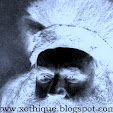A couple nights ago finished re-reading
Alfred Hitchcock's Ghostly Gallery: Eleven spooky stories for young people (and apparently for some big kids as well), from 1962. I previously read it when I was about 10 or 11, gleaning the tome from the school library or the public library, can't recall which. As with
Alfred Hitchcock's Monster Museum (see entry of 6 July 2012), one of the aspects that fascinated me were the
illustrations,
in this case by Fred Banbery:
http://jaargang.blogspot.com/2009/10/creepy-beautiful-illustrations.html,
http://illusstation.blogspot.com/2008/04/fred-banbery.html. The whimsically disturbing Hitchcock faces growing out of furniture attracted some study.
While not quite up to the pitch of shock and fright of the
Monster Museum, the
Ghostly Gallery infected my imagination. One of the two stories that affected me most during my initial reading were F. Marion Crawford's (
https://en.wikipedia.org/wiki/Francis_Marion_Crawford)
The Upper Berth,
penetrated with gelid and extirpative dread. The tale begins with a classic English ghost story framework (although Crawford was American, more or less), with a gentleman narrating the events over cigars... Bit of trouble in the old Hindu Kush. "He had about him, I thought, an air of rather dubious fashion: the sort of man you might see in Wall Street, without being able precisely to say what he was doing there." The second story in the anthology which impressed me the most in youth was H.G. Wells'
The Truth about Pyecraft, which is amusing but now strikes me as more of a bagatelle than some of the other pieces.
Robert Arthur:
http://www.elizabetharthur.org/bio/rarthur.html, who apparently also ghost-edited the Hitchcock collection, along with the
Monster Museum and some of the other Hitchcock-branded anthologies, is represented by no less than three good stories (ahem!):
The Haunted Trailer,
The Wonderful Day, and
Obstinate Uncle Otis. Arthur's writing appears light-hearted at first, but contains some dark turns as one reads on. Algernon Blackwood's (
http://en.wikipedia.org/wiki/Algernon_Blackwood) The Valley of the Beasts possesses one of the maestro's great atmospheric evocations of nature (the Canadian forest in this instance), but has a heavy-handedness about it at the end which places it at a lower grade than, say,
The Wendigo.
Other (mostly) excellent works appear by Robert Louis Stevenson, A.M. Burrage, Lord Dunsany, and Walter Brooks.



.jpg)











